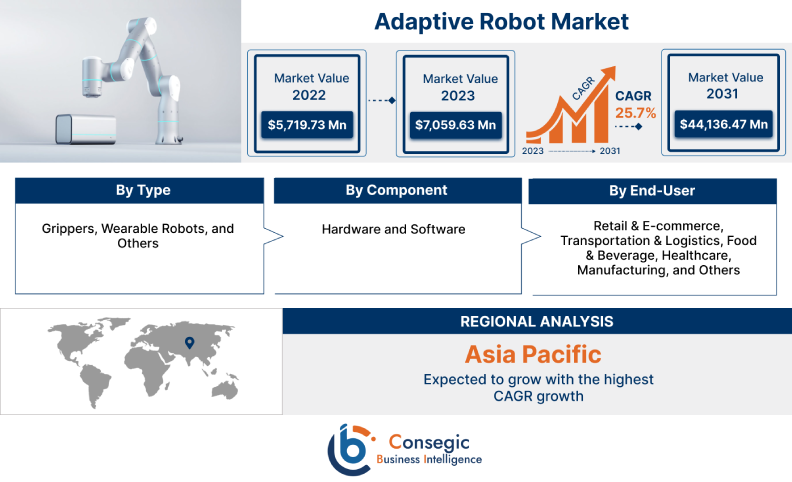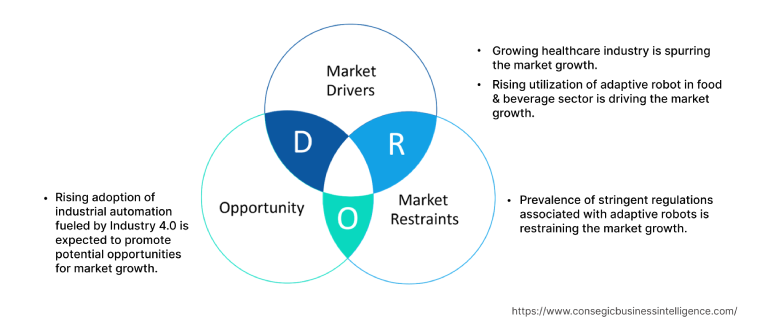- Summary
- Table Of Content
- Methodology
Adaptive Robot Market Size :
Adaptive Robot Market size is estimated to reach over USD 54,133.61 Million by 2032 from a value of USD 8,707.22 Million in 2024 and is projected to grow by USD 10,786.34 Million in 2025, growing at a CAGR of 25.70% from 2025 to 2032.
Adaptive Robot Market Scope & Overview:
Adaptive robot refers to a type of robot integrated with sensing, cognitive, and decision-making capabilities. Moreover, the deployment of robots offers several benefits including adaptable shape, multi-functionality, collision avoidance through impact absorption, high elasticity, and the ability to attain complex motion. The above benefits are key determinants for their increasing deployment in retail & e-commerce, transportation & logistics, food & beverage, healthcare, manufacturing, and other industries.
Adaptive Robot Market Insights :
Key Drivers :
Growing healthcare sector is spurring the market
Adaptive robots are primarily deployed in the healthcare sector for various applications including diagnostic, rehabilitation, and surgical procedures among others. They are used in the healthcare sector and are composed of materials that are similar in softness to human soft tissues. They are compatible with human interaction. Moreover, they are capable of matching with biological structures and have applications in artificial muscles, prosthetic devices, muscle alternatives, stents, catheters, and surgical instruments among others.
Factors including the increasing incidence of diagnostics and surgical procedures, growing trends in healthcare expenditure, and rising investments in advanced medical equipment are key prospects driving the healthcare sector.
For instance, according to the American Medical Association, the total healthcare spending in the United States reached up to USD 4.3 trillion in 2021, witnessing a rise in comparison to 2020. Healthcare expenditure in the United States accounted for 18.3% of the total GDP in 2021.
Additionally, the European Commission invested around USD 6 billion budget during the 2021-27 period to support the healthcare sector in Europe. Thus, the analysis of market trends shows that the growing healthcare sector is driving their adoption for application in rehabilitation, diagnostic, and surgical procedures among others, in turn, driving the adaptive robot market growth.
The rising utilization in the food & beverage sector is driving the market
Adaptive robots are used in the food & beverage sector, specifically for facilitating automation in food processing and manufacturing processes. Robots such as adaptive robotic grippers are primarily deployed in food processing facilities for applications ranging from handling and picking to packaging of food & beverage products. Moreover, they offer a range of benefits including greater adaptability, efficient handling of bulk products, reduced product damage, reduced automation footprint, and elimination of human touch among others. The above benefits are vital aspects for increasing their utilization in the food & beverage sector.
Factors including significant investments in the food & beverage sector, increasing hygiene standards in the food sector, growing consumer demand for packaged and processed food products, and rising demand for food processing automation solutions are crucial determinants for driving their adoption.
For instance, according to Food Drink Europe, a European Union confederation for the food sector, the European Union food and beverage sector was valued at EUR 1,121 billion (USD 1,292.0 billion) in 2022, representing an increase of 2.6% in comparison to EUR 1,093 billion (USD 1,177.8 billion) in 2021.
Thus, the market analysis shows that the growing food & beverage sector is increasing their adoption for applications ranging from handling, and picking to packaging of food & beverage products, in turn fostering adaptive robot market growth.
Key Restraints :
The prevalence of stringent regulations is restraining the market
The manufacturers have to compulsorily comply with various stringent standards such as the International Organization for Standardization (ISO 10218-1 and ISO 10218-2), EN 61000-6-2, EN 61000-6-4, and others, which is a prime factor restricting the market.
For instance, ISO 10218-1 specifies guidelines and requirements for the protective measures for safe design and information for utilization of industrial robots. The standard also highlights basic hazards related to robots and provides requirements for eliminating or reducing the risks associated with the hazards.
Additionally, ISO 10218-2 specifies safety requirements for the integration of industrial robots and industrial robot systems standards. ISO 10218-2 provides basic requirements for industrial robot systems, robot applications, and robot cells among others. Therefore, the analysis of market trends depicts that the prevalence of the aforementioned regulatory standards is limiting the adaptive robot market demand.
Future Opportunities :
Rising adoption of industrial automation fueled by Industry 4.0 is expected to promote potential opportunities for the market
Industry 4.0-enabled manufacturing depicts extreme flexibility, automation readiness, minimal human intervention, and the highest productivity. In addition, they are used for the assembly of several parts during industrial manufacturing. Moreover, their utilization also automates the process of picking and transporting individual items along with automating the handling and moving of parts & materials in industrial facilities. Their utilization of industrial automation offers several benefits including faster processes, high accuracy & precision, improved worker safety, and improved operational efficiency.
Factors including the rising pace of industrialization, increasing investments in the expansion of industrial manufacturing facilities, and the rising trend of industrial automation fueled by the revolution are expected to promote lucrative development aspects for the market.
For instance, the government of Germany launched the "Industry 4.0" initiative to promote the development of digital technologies in manufacturing. The initiative also aims at supporting automation in manufacturing along with enhancing Germany's competitiveness in the manufacturing sector. Therefore, the rising government initiatives towards industrial automation are anticipated to increase their application for automating industrial processes and improving operational efficiency, in turn promoting adaptive robot market opportunities during the forecast period.
Adaptive Robot Market Report Insights :
| Report Attributes | Report Details |
| Study Timeline | 2019-2032 |
| Market Size in 2032 | USD 54,133.61 Million |
| CAGR (2025-2032) | 25.7% |
| By Type | Grippers, Wearable Robots, and Others |
| By Component | Hardware and Software |
| By End-User | Retail & E-commerce, Transportation & Logistics, Food & Beverage, Healthcare, Manufacturing, and Others |
| By Region | North America, Europe, Asia-Pacific, Latin America, and Middle East & Africa |
| Key Players | ROBOTIQ, Siléane, Boston Dynamics, Adaptive Robot Inc., Yaskawa Electric Corporation, Ekso Bionics Holdings Inc., Rewalk Robotics Ltd., Festo Inc., RightHand Robotics Inc., Elephant Robotics Technology Co. Ltd., Flexiv Ltd |
Adaptive Robot Market Segmental Analysis :
By Type :
Based on the type, the market is segmented into grippers, wearable robots, and others. The grippers segment accounted for the largest revenue share in the year 2024 of the global adaptive robot market. They are designed for handling delicate objects without causing damage. Moreover, they have considerable flexibility that enables the robot to grasp a variety of objects. The high flexibility, versatility, adaptability, and dexterity are key determinants for increasing their application in food & beverage, logistics, retail & e-commerce, and manufacturing sectors among others.
For instance, ROBOTIQ offers a range of adaptive grippers in its product portfolio including a 3-finger adaptive robotic gripper and a Hand-E adaptive gripper among others. The adaptive grippers are designed for assembly and pick & place applications in industrial facilities. Thus, the segmental trends analysis shows that the rising development of adaptive grippers for utilization in industrial applications is among the prime factors driving the adaptive robot market demand.
The wearable robots segment is anticipated to register the fastest CAGR during the forecast period. They refer to a particular type of wearable device that is optimized to enhance a person's motion or physical abilities. Moreover, they are designed to assist impaired limbs, boost human ability, or help with the rehabilitation of neuromuscular impairments. Additionally, they offer several benefits including lightweight, increased functionality and mobility, ease of wear and removal, along continuous adaptability to evolving consumer demands. The above benefits are vital prospects driving its adoption in healthcare and other industrial sectors.
In September 2019, Hyundai launched its new wearable robot, the vest exoskeleton which is particularly developed for assisting industrial workers spending long hours working in overhead environments. The wearable robot helps improve productivity and reduce fatigue of industrial workers by imitating the movement of human joints to augment mobility and load support. Hence, analysis of segmental trends portrays that, the rising innovations associated with wearable robots are among the key factors driving the adaptive robot market opportunities.
By Component :
Based on components, the market is bifurcated into hardware and software. The hardware segment accounted for the largest revenue share in 2024 of the total adaptive robot market share. The primary hardware components include motors, sensors, microphones, actuators, cameras, and others. The hardware components help in enhancing the capabilities of the robot.
For instance, in December 2022, SMAC Corporation launched its LPL series of linear actuators that are particularly designed for utilization in robotic arms. The LPL series actuators deploy SMAC's moving coil linear servo motors for precision control in multiple industrial applications including pick-and-place tasks, parts finishing, and assembly operations among others. Therefore, the rising innovations associated with hardware components are proliferating the adaptive robot market trends.
The software segment is expected to witness the fastest CAGR during the forecast period. The software consists of a set of coded commands or instructions that guide the robot with the required tasks that it needs to perform. Software is primarily used for performing autonomous tasks and consists of frameworks that make the programming of robots easier.
In July 2023, BOW released its BETA version of a robotics software engine that enables users to code robots in two different programming languages and is further integrated with a custom Webots simulator. Thus, the segment analysis shows that the rising advancement associated with robotics software is anticipated to boost the adaptive robot market expansion during the forecast period.
By End-User :
Based on the end-user, the market is segregated into retail & e-commerce, transportation & logistics, food & beverage, healthcare, manufacturing, and others. The manufacturing segment accounted for the largest revenue share of 31.82% in the year 2024 of the overall adaptive robot market share. Factors including the rising pace of industrialization, increasing investments in the expansion of industrial manufacturing facilities, and the rising trend of industrial automation fueled by Industry 4.0 are driving the manufacturing segment.
According to the Federal Ministry for Economic Affairs and Climate Action of Germany, annual investments by the German manufacturing sector in Industry 4.0 applications will reach up to USD 49 billion by 2020. Hence, the growing manufacturing sector is driving the application of robots in manufacturing plants and warehouses for handling, picking, assembly, and packaging applications, in turn contributing to the adaptive robot market trends.
The healthcare segment is expected to witness the fastest CAGR during the forecast period. The growing healthcare segment is primarily driven by multiple factors including increasing incidence of diagnostics and surgical procedures, growing trends in healthcare expenditure, and rising investments in advanced medical equipment.
For instance, according to the European Commission, the total government healthcare expenditure in the EU reached up to USD 202.7 billion in 2021, accounting for 8.1% of the total GDP. Therefore, increasing investments in the healthcare sector are projected to increase the deployment of these robots for utilization in rehabilitation, diagnostic, and surgical procedures among others, thereby, driving the adaptive robot market expansion during the forecast period.
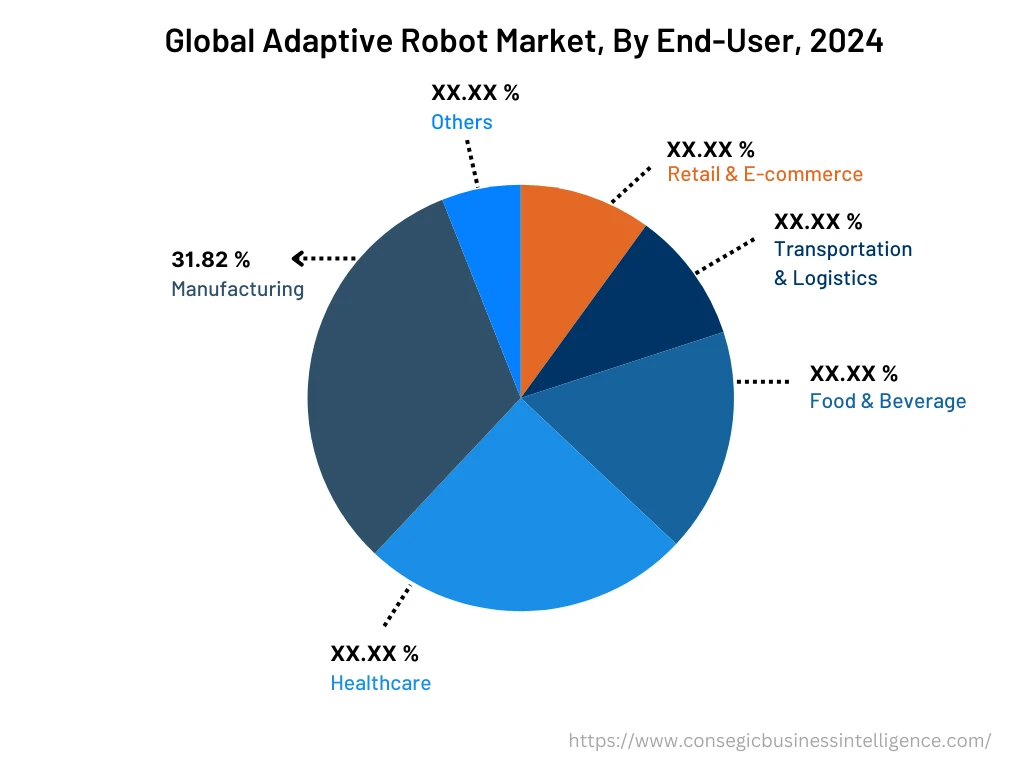
By Region :
The regional segment includes North America, Europe, Asia Pacific, the Middle East and Africa, and Latin America.
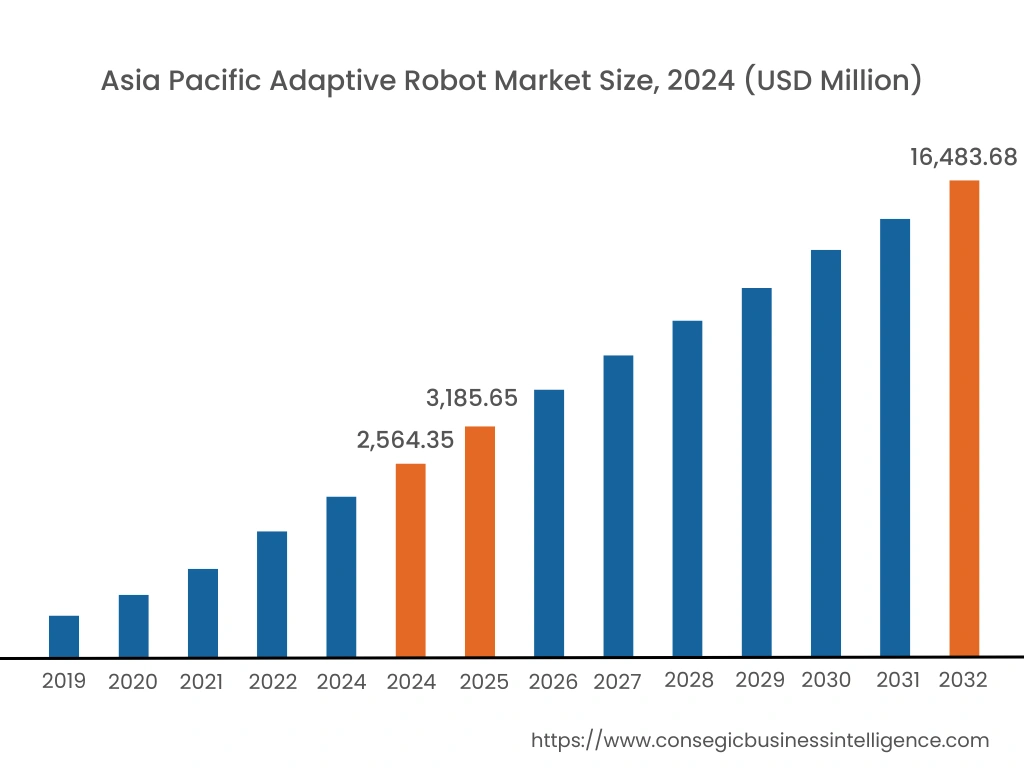
North America is estimated to reach over USD 17,544.70 Million by 2032 from a value of USD 2,888.26 Million in 2024 and is projected to grow by USD 3,571.08 Million in 2025.
As per the adaptive robot market analysis, the growth in North America is primarily driven by the deployment of robots in food & beverage, transportation & logistics, healthcare, and other industries. Additionally, the increasing application of these robots in food & beverage plants for picking, moving, assembling, and packing finished products is among the vital factors driving the market in the region.
For instance, in August 2021, Tyson Foods, invested USD 300 million to build a food processing facility in Virginia, U.S. The facility is scheduled to be operational in 2023. The above factors are fostering the growth of the adaptive robot market in the North American region. Furthermore, analysis of regional trends shows that the increasing investment in retail & e-commerce and logistics sectors is a vital factor expected to drive market growth in North America during the forecast period.
In Asia Pacific, the market is experiencing the fastest growth with a CAGR of 26.20% over the forecast period. In addition, in the region, China accounted for the maximum revenue share of 35.10% in the same year.
The growing pace of industrialization and development is creating lucrative growth prospects for the market in the region. Additionally, factors including the growth of multiple industries such as retail & e-commerce, manufacturing, and others are fostering the adaptive robots market in the Asia-Pacific region.
For instance, in April 2022, the Indian Government announced the launch of an online retail network across 100 cities in India, to provide consumers with an alternative to multinational platforms including Amazon and Flipkart. Thus, the regional trends show that the growing retail & e-commerce sector is anticipated to drive the utilization of these robots in retail warehouses for automating the processes involved in picking, handling, and packaging retail goods and products, in turn proliferating the market in the Asia-Pacific region during the forecast period.
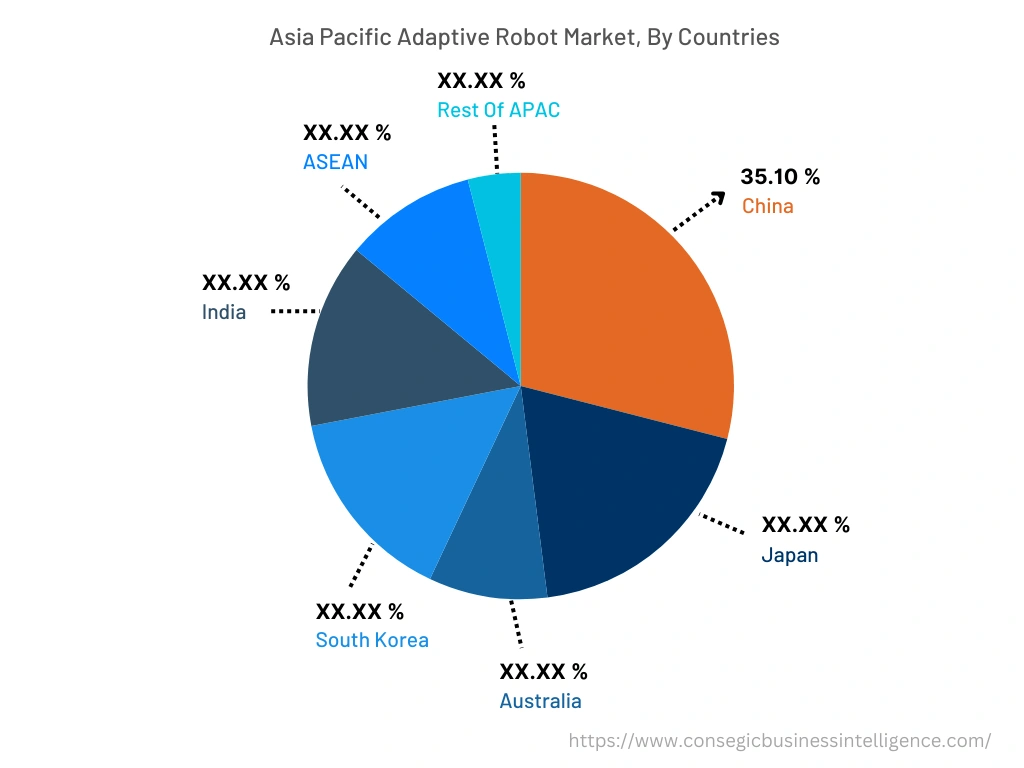
Top Key Players & Market Share Insights:
The adaptive robot market is highly competitive with major players providing robots to the national and international markets. Key players are adopting several strategies in research and development (R&D), product innovation, and end-user launches to hold a strong position in the adaptive robot market. Key players in the adaptive robot industry include-
- Boston Dynamics
- Adaptive Robot Inc.
- Yaskawa Electric Corporation
- Ekso Bionics Holdings Inc.
- Rewalk Robotics Ltd.
- Festo Inc.
Recent Industry Developments :
- In November 2020, Flexiv Ltd. announced the completion of the production of its 100th robot, representing substantial progress in the mass production of adaptive robots. It is integrated with industrial-grade force control, AI technology, and machine vision.
Key Questions Answered in the Report
What is adaptive robot? +
Adaptive robot refers to a type of robots integrated with sensing, cognitive, and decision-making capabilities for modifying their function and behaviour in response to contextual changes.
What specific segmentation details are covered in the adaptive robot report, and how is the dominating segment impacting the market growth? +
For instance, by type segment has witnessed gripper as the dominating segment in the year 2024, owing to the increasing adoption of adaptive grippers in food & beverage, logistics, retail & e-commerce, and manufacturing sectors among others.
What specific segmentation details are covered in the adaptive robot market report, and how is the fastest segment anticipated to impact the market growth? +
For instance, by end-user segment has witnessed healthcare as the fastest-growing segment during the forecast period due to rising deployment of adaptive robots in rehabilitation, diagnostic, and surgical procedures.
Which region/country is anticipated to witness the highest CAGR during the forecast period, 2025-2032? +
Asia-Pacific is anticipated to register fastest CAGR growth during the forecast period due to rapid pace of industrialization and growth of multiple industries such as retail & e-commerce, manufacturing, and others.
